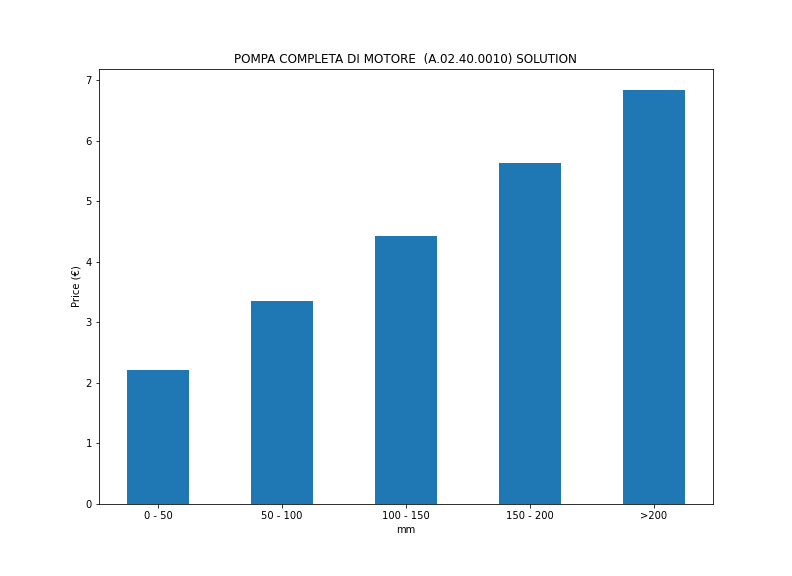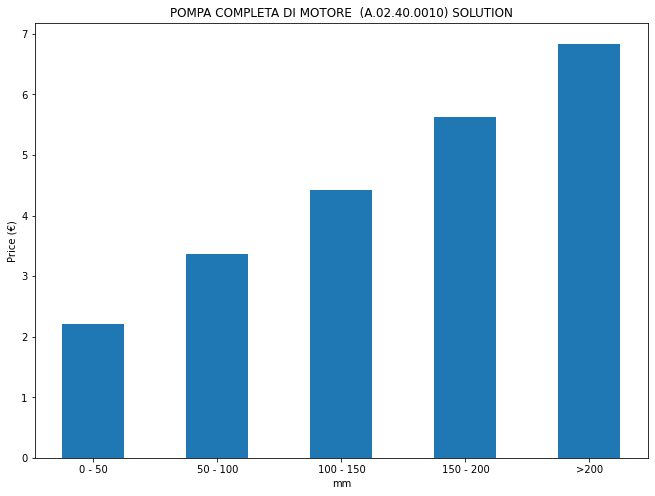Price catalog
Download worked project
Public administrations always need to know the up-to-date prices of all the various items they need, so to place appropriate orders to contractors. We’ll analyze the dataset EPPAT-2018-new-compact.csv, which is the price list for all products and services the Autonomous Province of Trento (Italy) may require.
Data source: dati.trentino.it, released under Creative Commons Attribution 4.0 licence.
What to do
Unzip exercises zip in a folder, you should obtain something like this:
price-catalog-prj
price-catalog.ipynb
price-catalog-sol.ipynb
EPPAT-2018-new-compact.csv
jupman.py
WARNING: to correctly visualize the notebook, it MUST be in an unzipped folder !
open Jupyter Notebook from that folder. Two things should open, first a console and then a browser. The browser should show a file list: navigate the list and open the notebook
price-catalog.ipynbGo on reading the notebook, and write in the appropriate cells when asked
Shortcut keys:
to execute Python code inside a Jupyter cell, press
Control + Enterto execute Python code inside a Jupyter cell AND select next cell, press
Shift + Enterto execute Python code inside a Jupyter cell AND a create a new cell aftwerwards, press
Alt + EnterIf the notebooks look stuck, try to select
Kernel -> Restart
The dataset
Let’s have a quick look at the file EPPAT-2018-new-compact.csv. We will show examples with pandas, but it is not required to solve the exercises.
DO NOT WASTE TIME LOOKING AT THE WHOLE DATASET!
The dataset is quite complex, please focus on the few examples we provide
[1]:
import pandas as pd
import numpy as np
pd.set_option('display.max_colwidth', None)
df = pd.read_csv('EPPAT-2018-new-compact.csv', encoding='latin-1')
The dataset contains several columns, but we will consider the following ones:
[2]:
df=df[['Codice Prodotto','Descrizione Breve Prodotto','Categoria','Prezzo']]
df[:22]
[2]:
| Codice Prodotto | Descrizione Breve Prodotto | Categoria | Prezzo | |
|---|---|---|---|---|
| 0 | A.02.35.0050 | ATTREZZATURA PER INFISSIONE PALI PILOTI | NaN | NaN |
| 1 | A.02.35.0050.010 | Attrezzatura per infissione pali piloti. | Noli e trasporti | 109.09 |
| 2 | A.02.40 | ATTREZZATURE SPECIALI | NaN | NaN |
| 3 | A.02.40.0010 | POMPA COMPLETA DI MOTORE | NaN | NaN |
| 4 | A.02.40.0010.010 | fino a mm 50. | Noli e trasporti | 2.21 |
| 5 | A.02.40.0010.020 | oltre mm 50 fino a mm 100. | Noli e trasporti | 3.36 |
| 6 | A.02.40.0010.030 | oltre mm 100 fino a mm 150. | Noli e trasporti | 4.42 |
| 7 | A.02.40.0010.040 | oltre mm 150 fino a mm 200. | Noli e trasporti | 5.63 |
| 8 | A.02.40.0010.050 | oltre mm 200. | Noli e trasporti | 6.84 |
| 9 | A.02.40.0020 | GRUPPO ELETTROGENO | NaN | NaN |
| 10 | A.02.40.0020.010 | fino a 10 KW | Noli e trasporti | 8.77 |
| 11 | A.02.40.0020.020 | oltre 10 fino a 13 KW | Noli e trasporti | 9.94 |
| 12 | A.02.40.0020.030 | oltre 13 fino a 20 KW | Noli e trasporti | 14.66 |
| 13 | A.02.40.0020.040 | oltre 20 fino a 28 KW | Noli e trasporti | 15.62 |
| 14 | A.02.40.0020.050 | oltre 28 fino a 36 KW | Noli e trasporti | 16.40 |
| 15 | A.02.40.0020.060 | oltre 36 fino a 56 KW | Noli e trasporti | 28.53 |
| 16 | A.02.40.0020.070 | oltre 56 fino a 80 KW | Noli e trasporti | 44.06 |
| 17 | A.02.40.0020.080 | oltre 80 fino a 100 KW | Noli e trasporti | 50.86 |
| 18 | A.02.40.0020.090 | oltre 100 fino a 120 KW | Noli e trasporti | 55.88 |
| 19 | A.02.40.0020.100 | oltre 120 fino a 156 KW | Noli e trasporti | 80.47 |
| 20 | A.02.40.0020.110 | oltre 156 fino a 184 KW | Noli e trasporti | 94.00 |
| 21 | A.02.40.0030 | NASTRO TRASPORTATORE CON MOTORE AD ARIA COMPRESSA | NaN | NaN |
Pompa completa a motore Example
If we look at the dataset, in some cases we can spot a pattern (rows 3 to 8 included):
[3]:
df[3:12]
[3]:
| Codice Prodotto | Descrizione Breve Prodotto | Categoria | Prezzo | |
|---|---|---|---|---|
| 3 | A.02.40.0010 | POMPA COMPLETA DI MOTORE | NaN | NaN |
| 4 | A.02.40.0010.010 | fino a mm 50. | Noli e trasporti | 2.21 |
| 5 | A.02.40.0010.020 | oltre mm 50 fino a mm 100. | Noli e trasporti | 3.36 |
| 6 | A.02.40.0010.030 | oltre mm 100 fino a mm 150. | Noli e trasporti | 4.42 |
| 7 | A.02.40.0010.040 | oltre mm 150 fino a mm 200. | Noli e trasporti | 5.63 |
| 8 | A.02.40.0010.050 | oltre mm 200. | Noli e trasporti | 6.84 |
| 9 | A.02.40.0020 | GRUPPO ELETTROGENO | NaN | NaN |
| 10 | A.02.40.0020.010 | fino a 10 KW | Noli e trasporti | 8.77 |
| 11 | A.02.40.0020.020 | oltre 10 fino a 13 KW | Noli e trasporti | 9.94 |
We see the first column holds product codes. If two rows share a code prefix, they belong to the same product type. As an example, we can take product A.02.40.0010, which has 'POMPA COMPLETA A MOTORE' as description (‘Descrizione Breve Prodotto’ column). The first row is basically telling us the product type, while the following rows are specifying several products of the same type (notice they all share the A.02.40.0010 prefix code until 'GRUPPO ELETTROGENO' excluded). Each
description specifies a range of values for that product: fino a means until to , and oltre means beyond.
Notice that:
first row has only one number
intermediate rows have two numbers
last row of the product series (row 8) has only one number and contains the word oltre ( beyond ) (in some other cases, last row of product series may have two numbers)
A1 extract_bounds
Write a function that given a Descrizione Breve Prodotto as a single string extracts the range contained within as a tuple.
If the string contains only one number n:
if it contains
UNTIL( ‘fino’ ) it is considered a first row with bounds(0,n)if it contains
BEYOND( ‘oltre’ ) it is considered a last row with bounds(n, math.inf)
DO NOT use constants like measure units ‘mm’, ‘KW’, etc in the code
Show solution[4]:
import math
#use this list to rmeove unneeded stuff
PUNCTUATION=[',','-','.','%']
UNTIL = 'fino'
BEYOND = 'oltre'
def extract_bounds(text):
raise Exception('TODO IMPLEMENT ME !')
assert extract_bounds('fino a mm 50.') == (0,50)
assert extract_bounds('oltre mm 50 fino a mm 100.') == (50,100)
assert extract_bounds('oltre mm 200.') == (200, math.inf)
assert extract_bounds('da diametro 63 mm a diametro 127 mm') == (63, 127)
assert extract_bounds('fino a 10 KW') == (0,10)
assert extract_bounds('oltre 156 fino a 184 KW') == (156,184)
assert extract_bounds('fino a 170 A, avviamento elettrico') == (0,170)
assert extract_bounds('oltre 170 A fino a 250 A, avviamento elettrico') == (170, 250)
assert extract_bounds('oltre 300 A, avviamento elettrico') == (300, math.inf)
assert extract_bounds('tetti piani o con bassa pendenza - fino al 10%') == (0,10)
assert extract_bounds('tetti a media pendenza - oltre al 10% e fino al 45%') == (10,45)
assert extract_bounds('tetti ad alta pendenza - oltre al 45%') == (45, math.inf)
A2 extract_product
Write a function that given a filename, a code and a unit, parses the csv until it finds the corresponding code and RETURNS one dictionary with relevant information for that product
Prezzo ( price ) MUST be converted to float
USE a
csv.DictReaderfor parsing, see exampleUSE
latin-1as encoding
[5]:
# Suppose we want to get all info about A.02.40.0010 prefix:
df[3:12]
[5]:
| Codice Prodotto | Descrizione Breve Prodotto | Categoria | Prezzo | |
|---|---|---|---|---|
| 3 | A.02.40.0010 | POMPA COMPLETA DI MOTORE | NaN | NaN |
| 4 | A.02.40.0010.010 | fino a mm 50. | Noli e trasporti | 2.21 |
| 5 | A.02.40.0010.020 | oltre mm 50 fino a mm 100. | Noli e trasporti | 3.36 |
| 6 | A.02.40.0010.030 | oltre mm 100 fino a mm 150. | Noli e trasporti | 4.42 |
| 7 | A.02.40.0010.040 | oltre mm 150 fino a mm 200. | Noli e trasporti | 5.63 |
| 8 | A.02.40.0010.050 | oltre mm 200. | Noli e trasporti | 6.84 |
| 9 | A.02.40.0020 | GRUPPO ELETTROGENO | NaN | NaN |
| 10 | A.02.40.0020.010 | fino a 10 KW | Noli e trasporti | 8.77 |
| 11 | A.02.40.0020.020 | oltre 10 fino a 13 KW | Noli e trasporti | 9.94 |
A call to
pprint(extract_product('EPPAT-2018-new-compact.csv', 'A.02.40.0010', 'mm'))
Must produce:
{'category': 'Noli e trasporti',
'code': 'A.02.40.0010',
'description': 'POMPA COMPLETA DI MOTORE',
'measure_unit': 'mm',
'models': [{'bounds': (0, 50), 'price': 2.21, 'subcode': '010'},
{'bounds': (50, 100), 'price': 3.36, 'subcode': '020'},
{'bounds': (100, 150), 'price': 4.42, 'subcode': '030'},
{'bounds': (150, 200), 'price': 5.63, 'subcode': '040'},
{'bounds': (200, math.inf),'price': 6.84, 'subcode': '050'}]}
Notice that if we append subcode to code (with a dot) we obtain the full product code.
[6]:
import csv
from pprint import pprint
def extract_product(filename, code, measure_unit):
raise Exception('TODO IMPLEMENT ME !')
pprint(extract_product('EPPAT-2018-new-compact.csv', 'A.02.40.0010', 'mm'))
assert extract_product('EPPAT-2018-new-compact.csv', 'A.02.40.0010', 'mm') == \
{'category': 'Noli e trasporti',
'code': 'A.02.40.0010',
'description': 'POMPA COMPLETA DI MOTORE',
'measure_unit': 'mm',
'models': [{'bounds': (0, 50), 'price': 2.21, 'subcode': '010'},
{'bounds': (50, 100), 'price': 3.36, 'subcode': '020'},
{'bounds': (100, 150), 'price': 4.42, 'subcode': '030'},
{'bounds': (150, 200), 'price': 5.63, 'subcode': '040'},
{'bounds': (200, math.inf),'price': 6.84, 'subcode': '050'}]}
#pprint(extract_product('EPPAT-2018-new-compact.csv', 'A.02.40.0020', 'KW'))
#pprint(extract_product('EPPAT-2018-new-compact.csv', 'B.02.10.0042', 'mm'))
#pprint(extract_product('EPPAT-2018-new-compact.csv','B.30.10.0010', '%'))
A3 plot_product
Implement following function that takes a dictionary as output by previous extract_product and shows its price ranges.
pay attention to display title and axis labels as shown, using input data and not constants.
in case last range holds a
math.inf, show a>signif you don’t have a working
extract_product, just copy paste data from previous asserts.
>>> extract_product('EPPAT-2018-new-compact.csv', 'A.02.40.0010', 'mm')

[7]:
%matplotlib inline
import numpy as np
import matplotlib.pyplot as plt
def plot_product(product):
raise Exception('TODO IMPLEMENT ME !')
product = extract_product('EPPAT-2018-new-compact.csv', 'A.02.40.0010', 'mm')
#product = extract_product('EPPAT-2018-new-compact.csv', 'A.02.40.0020', 'KW')
#product = extract_product('EPPAT-2018-new-compact.csv', 'B.02.10.0042', 'mm')
#product = extract_product('EPPAT-2018-new-compact.csv','B.30.10.0010', '%')
plot_product(product)
